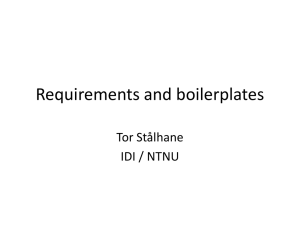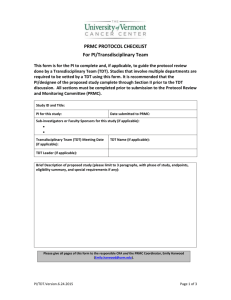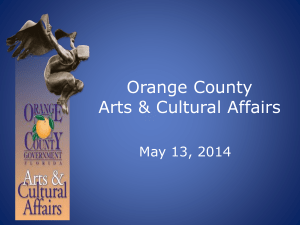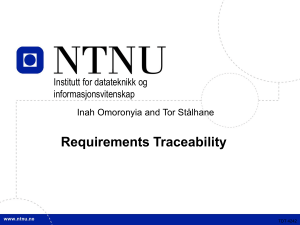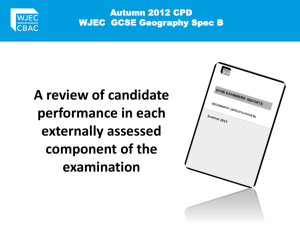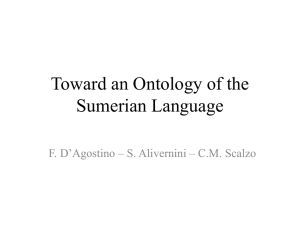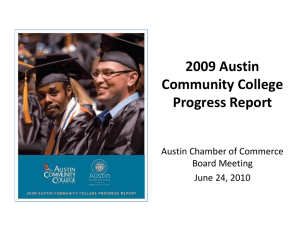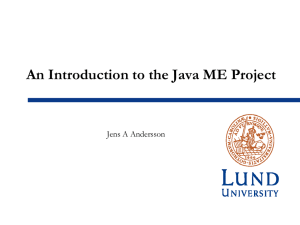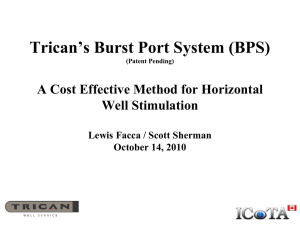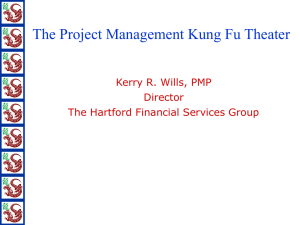Funding IT / KM
advertisement
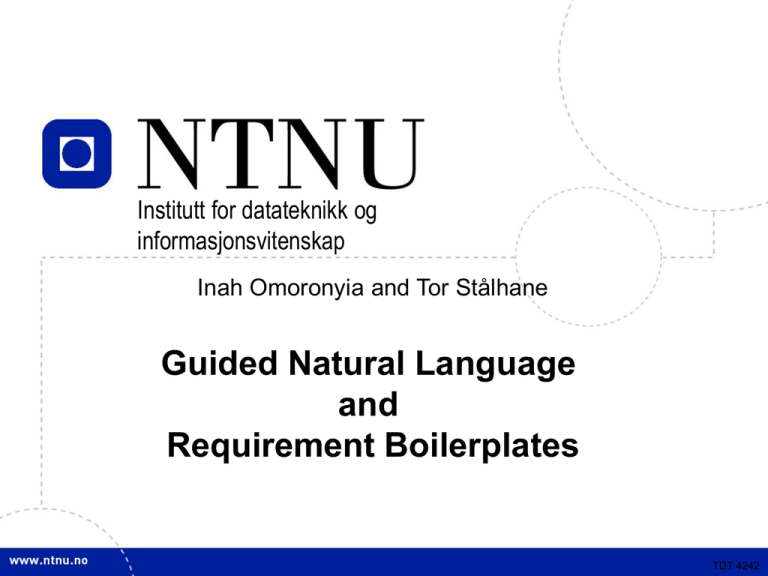
Institutt for datateknikk og informasjonsvitenskap Inah Omoronyia and Tor Stålhane Guided Natural Language and Requirement Boilerplates TDT 4242 TDT 4242 Requirements There are three levels of requirements: • Informal – e.g. Natural language (NL): free text, no rules apply • Semiformal • Guided Natural Language (GNL): free text but allowable terms are defined by a vocabulare • Boilerplates (BP): structured text and an ontology – vocabulary plus relationships between terms • Formal: e.g. state diagrams or predicate logic TDT 4242 Requirements elicitation Step 1: Capture Requirements in Natural Language Req.012: The system shall enable cabin temperature regulation between 15°C and 30°C … … Req.124: Cabin temperature shall not exceed 35° Step 2: Transfer Requirements and functions into a semi-formal requirements model Function 1 Function 2 Req 001 Req 002 Req 012 … Req 124 Req 011 Req 028 Req 050 … … Step 3: Refine the requirements model and derive detailed requirements Function 1 Function 1a Function 1b Req 001.01 Req 001.02 …. Function 1c Parallel Steps: Apply dictionary with common vocabulary; validate and check Requirements consistency and completeness Step 4: Create a preliminary design model based on the requirement model (to be used and refined in SP3) Humans and machines – 1 Given the amount and complexity of RE, we need to automate as much as possible. Humans and machines have different strong and weak points. We want to elicit and analyze requirements in a way that allows both parties to build on their strong sides. Humans and machines - 2 Machines are good at observing quantitative data and being deductive, fast and precise. In addition, they are good at doing consistent repetition of several actions. bad at handling variations in written material and pattern recognition. Humans are good at handling variations in written material, being inductive. In addition, they are good at doing error correction. Why BPs and GNL – 1 GNL and BPs will reduce variation and thus giving the machines the opportunity to do what they are best at: to be fast, precise and consistent. By combining humans and machines and let both do what they are best at, we get a better result than we would get if we left the job of handling requirements to just one of them. Why BPs and GNL - 2 The final goal is to allow the machine to assist the developers in analysing requirements for: Consistency Completeness Safety implications GNL and BPs Template based textual Guided RSL = Boilerplates Syntax + Semantics Keywords: Reflects requirement, system and domain concepts Requirements expressed on templates Uses predefined templates based on concepts, relations and axioms to guide requirements elicitation + Analysis -Correctness -Completeness -Consistency -Safety analysis Meta Model RMM - Refinement - Specialization Example: The <system function> shall provide <system capability> to achieve <goal> Requirements expressed using a vocabulary guide Uses predefined concepts, relations and axioms to guide requirements elicitation Example: The ACC system shall be able to determine the speed of the ego-vehicle. Ontology: General and SP specific - Requirements classification - System attributes - Domain concepts What is GNL - 1 Free text requirement elicitation with the assistance of prescribed words from a dictionary. This will give us requirements which use all terms in a uniform way, this reducing misunderstandings No formal constraints Requires minimal expertise. What is GNL - 2 Aim: • Bridge the gap between unconstrained expression and quality checking when representing requirements as free text. Quality measures: Correctness, consistency, completeness and unambiguity (reduced variability) • Provide the basis for semantic processing and checking of requirements. • Dictionary – Simple taxonomy or more formal ontology Approach for GNL – 1 Ontology = Thesaurus + Inference Rules • Thesaurus – Domain concepts: entities, terms and events • Inference Rules – Relations, attributes and axioms • Causality, similarity, reflexivity, transitiveness, symmetric, disjoint (contradiction) … Approach for GNL – 2 Required Activity Knowledge capture: Information embedded in domain events from domain experts and ontologist Implementation: Formal representation of captured knowledge. Language: OWL, Support environment: Protégé. Verification: Checking that represented ontology is correct using • Classifiers/reasoners • Domain experts (semantic accuracy) • Mapping of requirement segments to ontology concepts Motivation for use of templates - 1 Text has the advantage of unconstrained expression. There is, however, a need for common • Understanding of concepts used to express the requirements and relations between them. • Format of presentation Lack of common understanding makes requirement specifications expressed as free text prone to ambiguous representations and inconsistencies. TDT 4242 Motivation for use of templates - 1 Template based textual requirements specification (boilerplates) will introduce some limitations when representing requirements but will also reduce the opportunity to introduce ambiguities and inconsistencies. Boilerplates • Provides an initial basis for requirements checking • Are easy to understand for stakeholders compared to more formal representations TDT 4242 What is a boilerplate – 1 Boilerplates is a set of structures that can be used to write requirements. They use high-level concept classification and attributes TDT 4242 What is a boilerplate – 2 The RE process is as follows: 1. Select a boilerplate or a sequence of boilerplates. The selection is based on the attributes that need to be included and how they are organized – fixed terms. 2. If needed, identify and include mode boilerplates 3. Instantiate all attributes A boilerplate consists of fixed terms and attributes. It may, or may not, contain one or more modes. TDT 4242 Fixed Terms Attributes Boilerplate examples - 1 BP32 The <user> shall be able to <capability> Attributes: • <user> = driver • <capability> = start the ACC system Requirement The driver shall be able to start the ACC system TDT 4242 Boilerplate examples - 2 BP2 The <system> shall be able to <action> <entity> Attributes: • <system> = ACC system • <action> = determine • <entity> = the speed of the ego-vehicle Requirement The ACC system shall be able to determine the speed of the ego-vehicle TDT 4242 Boilerplate examples - 3 BP43 While <operational condition> BP32 The <user> shall be able to <capability> BP43 is a mode Attributes • <operational condition> = activated • <user> = driver • <capability> = override engine power control of the ACC system Requirement While activated the driver shall be able to override engine power control of the ACC-system TDT 4242 Functional requirements example Functional requirements from the SafeLoc system The robot control system shall stop the robot within 10 milliseconds if a gate is opened to the zone where the robot is operating The robot shall only be allowed to start when all gates are closed and the reset button is pushed The robot shall stop if it tries to move into a zone already occupied by an operator TDT 4242 Non functional requirement example – 1 Non-functional requirements and soft goals fits into the same BPs as functional requirements BP61 The <system> shall be able to <action> to <entity> Suitability: The <system > shall be able to <provide an appropriate set of functions> to <the user> TDT 4242 Non functional requirement example – 2 Non-functional requirements and soft goals fits into the same BPs as functional requirements BP2-1 The <system> shall be able to <capability> BP12 …for a sustained period of at least <number> < unit> Maturity: The <system > shall be able to <operate without failure> for a sustained period of at least <quantity> <time unit> TDT 4242 Non functional requirement example – 3 BP43 While <operational condition> BP2 The <system> shall be able to <action> <entity> While <normal operational condition> the <system> shall be able to <tolerate> <90% of software faults of category...> Summing up The use of boiler plates and ontologies will • Enforce a uniform use of terms • Reduce the variability of presentations – requirements that are similar will look similar Reduced variation in form and contents simplifies the use of automatic and semi-automatic tools for • Checking requirement quality – e.g completeness and consistency • Creating test cases TDT 4242
